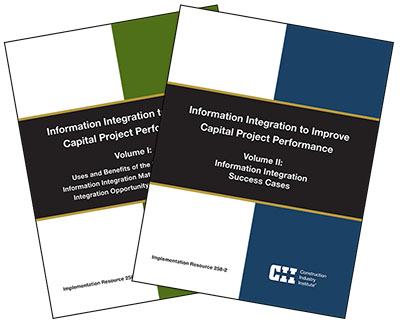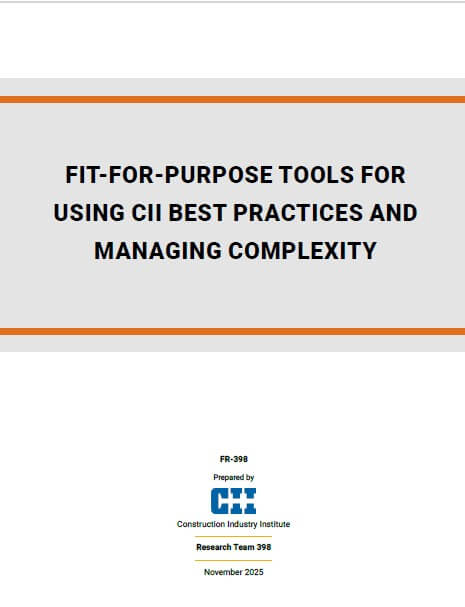
Information Integration to Improve Capital Project Performance
Capital projects execution involves the processing of massive amounts of data within and across many interfaces. Information integration—a combination of technologies, work processes, and supportive organizational structures and roles—is seen by many as a way to help the industry speed project execution while also increasing quality and reducing costs. Research Team (RT) 258 reviewed the current state of information integration practice in the industry and found that performance is well below the potential of current technologies—even for leading firms. It is now up to the industry to develop the work processes to leverage existing technologies and move forward.
Regardless of their current information integration status, all CII member companies face significant challenges to understanding where they currently stand and how to advance effectively and efficiently. Companies that want to improve must address some of the following questions:
- What are our process gaps? What are critical interfaces that can be improved by information integration?
- We can think of numerous integration opportunities—how do we prioritize them?
- Information integration is complex—where do we start?
- What should drive our decision?
- Where do we stand among peers/others?
The integration challenges are real. Unfortunately, there is a lack of tools to help companies analyze their current status and provide clarity about how to proceed.
In response to this need, CII RT 258 developed a detailed process and tools that allow a company to assess its current status, identify a range of information integration opportunities (IOPs), and prioritize and select specific IOPs for implementation. Specifically, RT 258 provides the following resources:
- A process map that identifies key steps by which firms can evaluate their current status, indentify specific IOPs, and prioritize them for implementation.
- The three-level Capital Projects Information Integration Maturity Model, through which a firm can perform a general assessment of its overall maturity level, and a detailed assessment of its maturity in eight functional areas. This tool will also help a firm develop a portfolio of IOPs that are tailored to its specific situation and that will provide the basis for systematic planning and investment.
- An Integration Opportunity Assessment Tool (IOP Tool) implemented in MS Excel that assesses the degree of each benefit and hindrance restricting implementation of specific IOPs. The IOP Tool allows relative assessment and prioritization of different IOPs, and produces a list of strongest hindrances as assessed for each IOP. This list can also be used to develop mitigation plans.
- A set of case studies of successful information integration efforts. Case studies are associated with maturity model level and IOP Tool scores so they can be evaluated in the context of these tools. The case studies detail success across several critical execution interfaces. These case studies are detailed in Volume II of this implementation resource.
Collectively, the process, tools, and case studies provide a significant advance to existing ad hoc information integration planning and deployment practices. While the tools and cases can be used to support narrow efforts, they are most beneficial when used to systematically assess a company’s investment in information integration technologies and processes. Note that RT 258 tools do not prescribe what a company should do; the process and tools described below provide a structured approach for corporate assessment, opportunity identification, prioritization, and planning for implementation.
The following chapters and appendices, together with the IOP Tool, first show how to use the process, then offer implementation examples. The following sections of this chapter describe the current state of information integration in the industry and the relationship between the process and tools developed by the RT 258 team and other industry initiatives. Chapter 2 provides an overview of the RT 258 process, which incorporates and relates the assessments provided by the maturity model and IOP Tool. Chapter 3 describes the maturity model in both its general and detailed formats and explains how to deploy it to assess a firm’s current level of information integration and then generate a portfolio of integration opportunities. Chapter 4 describes the IOP Tool and its use for evaluating specific integration opportunities. As a companion to the RT 258 process and tools, Volume II presents a set of information integration success cases reported by team member companies. Appendix A of this volume describes the IOP Tool components and algorithm in detail to offer a deeper look at the tool and to present a basis from which to modify its function. Appendix B provides more details about sample deployments of the RT 258 process, the maturity model, and the IOP Tool. Appendix C provides the maturity model in both its general and detailed formats.
There are three discrete steps to assess an integration opportunity. (IR258-2-v1, p. 9)
- Evaluate and score the portfolio of integration opportunity proposals (IOP) developed in the maturity model process.
- Select key IOP’s for further analysis.
- Refine analysis of selected IOP’s.
IR258-2, Information Integration to Improve Capital Project Performance, Volume I: Uses and Benefits of the Capital Project Information Integration Maturity Model and Integration Opportunity Assessment Tool
This resource includes:
- Capital Projects Information Maturity Model – Firms can perform a general assessment of its overall maturity level, and a detailed assessment of its maturity in 8 functional areas.
- Integration Opportunity Assessment Tool (IOP Tool) – Assesses the degree of each benefit from and hindrance to the implementation of specific IOPs. This tool can also be used to develop mitigation plans.
- General Maturity Model (Appendix C, p74)
- Detailed Maturity Model (Appendix C, p76)
IR258-2, Information Integration to Improve Capital Project Performance, Volume II: Information Integration Success Cases
This volume contains 9 case studies that reflect a range of information integration successes, but by no means represent the full scope of integration opportunities available to the industry. The case studies provide relevant data and information that may apply to your investments in information integration.



